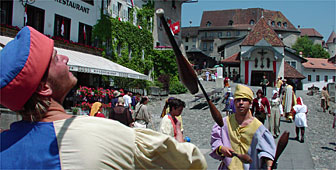Medieval troupes take up gauntlet for Gruyères

Period re-enactments are breathing life back into some of Switzerland's picturesque medieval towns - including Gruyères.
Jugglers, artisans, musicians and food and drink vendors of all medieval stripes greeted those who entered the gates of the old town of Gruyères last Saturday.
Flies buzzed around the head and fur of a freshly killed wild boar laid out for all to see on the cobblestones. At a table behind, a butcher chopped the grilled boar meat into manageable pieces.
In a military encampment outside the town walls, an officer put his foot soldiers through their marching paces. A cannon fired.
Gorgeous set
On most days of the year, the well-preserved old town of Gruyères and castle resemble a gorgeous set where the actors have long since left the stage. And it is normally left up to the one and a half million tourists who visit the town each year to imagine what life must have been like when it was lorded over by the Counts of Gruyères.
Not so on Saturday. The occasion was the Festival of St John, a ceremony and celebration taken from the pages of Gruyères’ medieval history:
Each year, the count would lead a procession of the local gentry to the castle chapel where St John was asked for protection. Taking part in the procession in the year 1504 was the newlywed son of the count and his bride, whose marriage ended a decades-old feud between the count and an archrival.
Hundreds of locals dressed in their finest Middle Ages’ garb for the occasion, and groups specialising in period re-enactments lent the affair a certain authenticity.
It is like a “dream” says tourist director, Pierre-André Briguet, “like you are in a film”.
The most prominent of the re-enactment groups was “The Company of Saynt George” – which portrays a 15th century military company of castle garrison, in the service of Burgundy.
Archers
Its members came from across Europe and represented halberd-carrying foot soldiers, archers, guards, aristocrats and a colourful assortment of musicians, seamstresses and their children.
“The costumes are all recreated from what small amount of documentation we have whether it’s iconographical or archaeological sources from the late 15th century,” says company member, John Howe.
Howe is better known as an illustrator of fantasy art who worked as a conceptual artist on the Lord of the Rings film.
Social leveller
“We do it for our pleasure and for the pleasure that we have in researching the material and for actually getting it into the field so to speak” Howe continues.
“So all of the men have a military role which they are capable of assuming. The military role is a great social leveller because it means that everyone shares in all the chores from the washing up to the setting up of camp to the breaking up of camp.”
The Burgundian army of the late 15th century was bolstered by foreign mercenaries, as is The Company of Saynt George. The Swede Alex Graff plays a soldier, who was weighed down by about 20 kilogrammes of non-breathable armour in 30-degree heat.
“There were two distinct styles of armour in Europe. The German or gothic style which is more spiky and fluted and decorated and the Italian style which is more plain and functional,” Graff explains.
“And different countries preferred different styles. In England the Italian or Milanese style of armour was very popular.”
Sweating under their gleaming armour, Graff and the other soldiers of The Company of St George led the count’s procession to the castle chapel.
Like theatre
“Re-enactments are like theatre and we do it because we like the armour and we like the swords,” says member Christian Folini, who is the company’s only historian, and surprisingly – a professed pacifist.
“We do no battle re-enactments. We do the civilian preparations for war but we don’t play the war in itself and I think that’s the position where we step back from the actual reality of the 15th century,” he says.
Also dressed in costume on this day were two local teenagers soliciting donations for a project to repave the streets of the old town entirely with cobblestones.
It was proof, to a certain extent, that it is possible to turn back the clock in Gruyères.
by Dale Bechtel
Medieval festivals
Switzerland’s medieval festivals are concentrated in French-speaking western Switzerland. The next event takes place in Estavayer-le-lac from July 12 to 14, followed by Grandson on August 17 and 18 and a week later in Bellelay/Moutier. The festival season comes to an end with a weeklong celebration in Fribourg beginning on September 6. Those interested in finding out more about Switzerland in the 15th century should head to the Swiss national exhibition site at Murten, where a 19th century panorama of the Battle of Murten has been restored and placed on public view. In the famous battle, the Swiss-led troops massacred the Burgundian forces of Charles the Bold.

In compliance with the JTI standards
More: SWI swissinfo.ch certified by the Journalism Trust Initiative
You can find an overview of ongoing debates with our journalists here. Please join us!
If you want to start a conversation about a topic raised in this article or want to report factual errors, email us at english@swissinfo.ch.